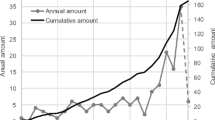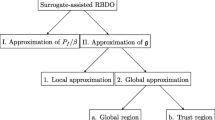Abstract
Goal, Scope, and Background
As Life Cycle Assessment (LCA) and Input-Output Analysis (IOA) systems increase in size, computation times and memory usage can increase rapidly. The use of efficient methods of solution allows the use of a wide range of analysis techniques. Some techniques, such as Monte-Carlo Analysis, may be limited if computational times are too slow.
Discussion of Methods
In this article, I describe algorithms that substantially reduce computation times and memory usage for solving LCA and IOA systems and performing Monte-Carlo analysis. The algorithms are based on well-established iterative methods of solving linear systems and exploit the power series expansion of the Leontief inverse. The algorithms are further enhanced by using sparse matrix algebra.
Results and Discussion
The algorithms presented in this article reduce computational time and memory usage by orders of magnitude, while still retaining a high degree of accuracy. For a 3225×3225 LCA system, the algorithm reduced computation time from 70s to 0.06s while retaining an accuracy of 10−3%. Storage was reduced from 166 megabytes to 1.8 megabytes. The algorithm was used to perform a Monte-Carlo analysis on the same system with 1,000 samples in 90s. I also discuss various issues of power series convergence for general LCA and IOA systems and show that convergence will generally hold due to the mathematical structure of LCA and IOA systems.
Conclusions
By exploiting the mathematical structure of LCA and IOA iterative techniques substantially reduced the computational times required for solving LCA and IOA systems and for performing Monte-Carlo simulations. This allows more wide-spread implementation analysis techniques, such as Monte-Carlo analysis, in LCA and IOA.
Recommendations and Perspectives
It is suggested that algorithms, such as the ones described in this article, should be implemented in LCA packages. Various checks can be used to verify that computational errors are kept to a minimum.
Similar content being viewed by others
References
Baumann H, Tillman A-M (2004): The hitch hiker’s guide to LCA: An orientation in life cycle assessment methodology and application. Studentlitteratur, Lund
Berger W, Saibel E (1957): Power series inversion of the Leontief matrix. Econometrica 25(1) 154–165
Bullard CW, Sebald AV (1988): Monte Carlo sensitivity analysis of input-output models. The Review of Economics and Statistics 70(4) 708–712
Bureau of Economic Analysis (2005): Bureau of Economic Analysis: Industry economic accounts. Online database: Accessed 13 January, 2005, Bureau of Economic Analysis, URI 〈http://www.bea.doc.gov/bea/dn2/i-o.htm〉
Ciroth A, Fleischer G, Steinbach J (2004): Uncertainty calculation in life cycle assessments: A combined model of simulation and approximation. Int J LCA 9(4) 216–226
Datta B (1995): Numerical linear algebra and applications. Brooks/Cole Publishing Company
Frischknecht R, Jungblush N (2004): Overview and methodology. ecoinvent report No. 1, Swiss Centre for Life Cycle Inventories, URL 〈http://www.ecoinvent.ch/〉
Hackbusch W (1994): Iterative Solution of Large Sparse Systems of Equations. Springer-Verlag, New York
Hawkins D, Simon HA (1949): Note: Some conditions of macroeconomic stability. Econometrica 17(3) 245–248
Heijungs R (1994): A generic method for the identification of options for cleaner production. Ecological Economics 10, 69–81
Heijungs R, Suh S (2002): Computational structure of life cycle assessment. Kluwer Academic Publications, Dordrecht, The Netherlands
Heijungs R, Suh S, Kleijn R (2005): Numerical approaches to life cycle implementation: The case of the ecoinvent’96 database. Int J LCA 10(2) 103–112
Hendrickson C, Horvath A, Joshi S, Lave L (1998): Economic input-output models for environmental life-cycle assessment. Environmental Science and Technology 32(7) 184A–191A
Hertwich EG (2005): Lifecycle approaches to sustainable consumption: A critical review. Environmental Science and Technology 39(13) 4673–4684
Hocking MB (1991): Paper versus polystyrene: A complex choice. Science 251, 504–505
Huijbregts MA, Gilijamse W, Ragas AM, Reijnders L (2003): Evaluating uncertainty in environmental life-cycle assessment. A case study comparing two insulation options for a Dutch one-family dwelling. Environmental Science and Technology 37, 2600–2608
Huijbregts M A, Norris G, Bretz R, Ciroth A, Maurice B, von Bahr B, Weidema B, de Beaufort AS (2001): Framework for modelling data uncertainty in life cycle inventories. Int J LCA 6(3) 127–132
Joshi S (1999): Product environmental life-cycle assessment using input-output techniques. Journal of Industrial Ecology 3(2–3) 95–120
Lave L, Cobas-Flores E, Hendrickson C, McMichael F (1995): Using input-output analysis to estimate economy-wide discharges. Environmental Science and Technology A 29(9) 420A–426A
Lenzen M (2001): A generalized input-output multiplier calculus for Australia. Economic Systems Research 13(1) 65–92
Lenzen M (2003): Environmentally important paths, linkages and key sectors in the Australian economy. Structural Change and Economic Dynamics 10(6) 545–572
Leontief W (1970): Environmental repercussions and the economic structure: An input-output approach. The Review of Economics and Statistics 52(3) 262–271
Miller R, Blair P (1985): Input-output analysis: Foundations and extensions. Englewood Cliffs, NJ, Prentice-Hall
Morgan M, Henrion M (1990): Uncertainty: A guide to dealing with uncertainty in quantitative risk and policy analysis. Cambridge University Press
Nakamura S, Kondo Y (2002): Input-output analysis of waste management. Journal of Industrial Ecology 6(1) 39–63
Nicholson WK (1990): Elementary linear algebra with applications. PWS-Kent Publishing Company
O’Neill MJ, Wood RJ (1999): An alternative proof of the Hawkins-Simon Condition. Asia-Pacific Journal of Operational Research 16, 173–183
Peters GP, Hertwich EG (2006): A comment on ‘Functions, commodities and environmental impacts in an ecological-economic model’. Ecological Economics, Forthcoming
Saad Y (1996): Iterative Methods for Sparse Linear Systems. PWS Publishing Company, Boston
Seneta E (1973): Non-negative matrices: An introduction to theory and applications. George Allen & Unwin Ltd
Stewart GW (1973): Introduction to matrix computations. Academic Press
Strømman AH, Solli C, Hertwich EG (2006): Hybrid life-cycle assessment of natural gas based fuel chains for transportation. Environmental Science and Technology 40(8) 2797–2804
Suh S (2004): Functions, commodities and environmental impacts in an ecological-economic model. Ecological Economics 40(4) 451–467
Suh S (2006): Reply: Downstream cut-offs in Integrated Hybrid Life Cycle Assessment. Ecological Economics (forthcoming)
Suh S, Lenzen M, Treloar GJ, Hondo H, Horvath A, Huppes G, Jolliet O, Klann U, Krewitt W, Moriguchi Y, Munksgaard J, Norris G (2004): System boundary selection in life-cycle inventories using hybrid approaches. Environmental Science and Technology 38(3) 657–664
United Nations (1993): System of National Accounts 1993. United Nations
United Nations (1999): Handbook of input-output table compilation and analysis. Studies in Methods Series F, No 74, Handbook of National Accounting, United Nations
Varga RS (2000): Matrix iterative analysis, 2nd Edition. Springer
Watkins DS (2002): Fundamentals of Matrix Computations, 2nd Edition. Wiley-Interscience, New York
Waugh FV (1950): Inversion of the Leontief matrix by power series. Econometrica 18(2) 142–154
Wood RJ, O’Neill M (2002): Using the spectra radius to determine whether a Leontief system has a unique positive solution. Asia-Pacific Journal of Operational Research 19, 233–247
Wood RJ, O’Neill MJ (2004): An always convergent method of finding the spectral radius of an irreducible non-negative matrix. Australian & New Zealand Industrial and Applied Mathematics Journal 45, C475–C485
Author information
Authors and Affiliations
Corresponding author
Rights and permissions
About this article
Cite this article
Peters, G.P. Efficient algorithms for Life Cycle Assessment, Input-Output Analysis, and Monte-Carlo Analysis. Int J Life Cycle Assess 12, 373–380 (2007). https://doi.org/10.1065/lca2006.06.254
Received:
Accepted:
Published:
Issue Date:
DOI: https://doi.org/10.1065/lca2006.06.254




